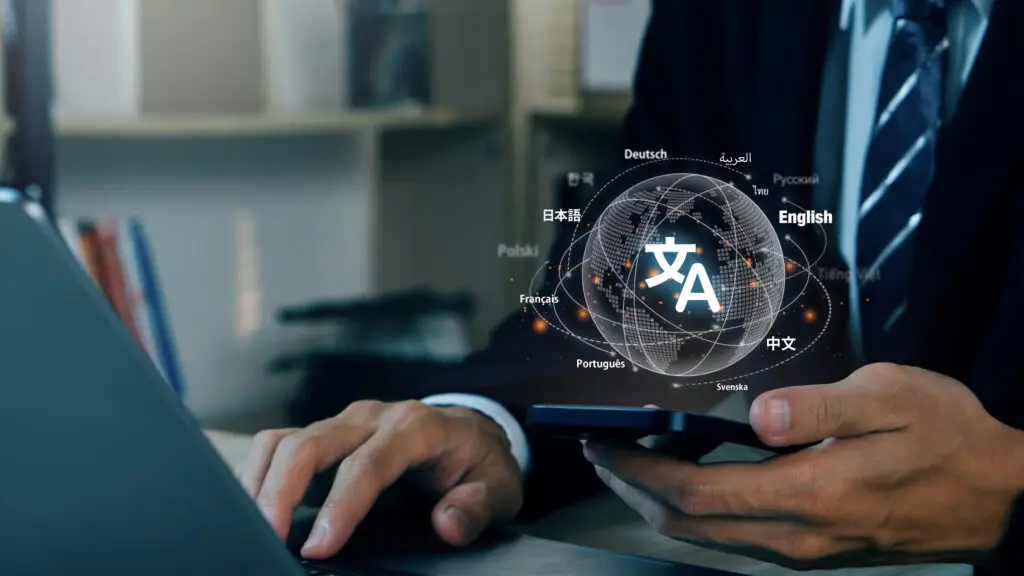- The SAFE-AI in Interpreting Task Force launched two surveys to gather information about AI in interpreting from stakeholders and end users.
- We have a unique and urgent opportunity to shape how AI is adopted in interpreting through identifying and promoting best practices.
- It’s up to us to take time to fill out these surveys so our profession and industry can implement AI to its greatest beneficial potential.
- Deadline: December 10th
More than ever, we live in a time of constant change and disruption. But seminal, transformative moments are still rare. For interpreting, the years 2011 and 2022 will go down in history as two such moments.
WebRTC and the emergence of remote interpreting
The release of WebRTC in 2011 marks the last time interpreting was upended by a new technology. WebRTC, or Web Real Time Communication, revolutionized online communication by democratizing access to voice and video calls, screen sharing, and peer-to-peer data transfer.
It led directly to the proliferation of internet-based over-the-phone and video remote interpreting technologies, especially in healthcare.
It’s not easy for entire professions to react proactively in the face of sudden change. When remote interpreting technology emerged, the pros and cons were debated amongst professionals, with much hand wringing and fear, but we didn’t guide its implementation. To this day, we haven’t invested in the research needed to understand how, when, where and why remote interpreting services are most effective in overcoming language barriers.

Remote interpreting is now commonplace. There is no doubt its adoption has greatly expanded language access and increased the number of interpreters and languages available. But it has not come without costs. We missed the first, most timely opportunity to build in global best practices, protect interpreter working conditions and understand how remote communication differs from being physically present. Today, our field has many effective, individual efforts to implement best practices, but does not have a shared consensus nor a full understanding of how to deploy remote interpreting to the greatest benefit of interpreters and those they interpret for.
ChatGPT and AI Interpreting
Fast forward eleven years; another consequential technology has arrived and is already profoundly disrupting our profession. The release of ChatGPT on November 30th, 2022 turned AI from science fiction into reality. AI is here, and the impact has been immediate and widespread.
According to the 2023 McKinsey Global Survey on the current state of AI, the growth of generative AI has been explosive.
“Less than a year after many of these tools debuted, one-third of our survey respondents say their organizations are using gen AI regularly in at least one business function…and three-quarters of all respondents expect gen AI to cause significant or disruptive change in the nature of their industry’s competition in the next three years.”
As a matter of fact, many language service companies and technology vendors have rolled out AI-supported interpreting tools in the last 12 months.
Speech-to-speech simultaneous machine translation and live multilingual captioning are being successfully implemented alongside traditional human interpreting, especially in conference interpreting settings. These services make it possible for multilingual communication to reach clients, meeting formats and language combinations that otherwise have not used human interpreting. It’s undeniable that they are cheaper and easier to access than human interpreters, and will inevitably replace some human interpreting as well.
On the other hand, those in health, legal, financial and other service settings, where mistakes made by AI could lead to subpar and even dangerous outcomes, are showing understandable caution in the rapid adoption of AI. These settings benefit from existing legislation and regulations that slow down the ad hoc adoption of new technologies to provide care or services.
Where remote interpreting transformed how we deliver human interpreting services through technology, AI means that human interpreters now co-exist alongside AI interpreters.

Video Remote Interpreting

AI-generated remote interpreter
Interpreting’s response: SAFE-AI Task Force
The stakes are high, and time is short to formulate a response that will protect hard-fought gains in a decades-long effort to professionalize human interpreting, while still allowing for AI technologies to increase and improve multilingual communication.
This is where you come in.
Last summer, stakeholders from many sides of the interpreting industry came together to launch the SAFE-AI in Interpreting Task Force to “establish, disseminate and promote industry-wide guidelines and best practices for the responsible adoption of AI in interpreting.”
The Task Force’s first project is to rapidly gauge how much AI is being actively used across stakeholder groups and how AI is viewed. Is it an opportunity? A threat? A mix of both? Which settings are more likely to be impacted? Is it okay, for example, in some patient or educational encounters but not in others?
To that end, the Task Force has launched two perception surveys:
The Market Survey, Perceptions from the Market. gauges the perspectives and expectations of all other stakeholders, including interpreters, researchers, professional associations, vendors, buyers, and other stakeholders in language access.
The End-User Survey, Perceptions from Actual Users of Interpreting Services, seeks to capture the diverse experiences and insights of end users, primarily the recipients of services. The survey is available in 11 languages, including American Sign Language.

Market Survey, Perceptions from the Market, CSA Research
The results of these two surveys will contribute to a broader understanding of the AI landscape and inform the Task Force’s work to establish best practices for the appropriate use of AI in interpreting.
Whether we like it or not, AI is here. Now it’s up to us to be proactive. The pace of change can be exhausting, and it’s normal to think “what can I do?” The SAFE-AI Perception Surveys are an easy yet critically important way that you can contribute to the immediate future of our profession.
Here’s what you can do:
Don’t delay, take the survey today, then share the link to your network. The surveys are open until December 10th, 2023. The survey results will be published in a report in January 2024.
- To learn more about the SAFE-AI Perception Survey, visit this page.
- To learn more about the SAFE-AI in Interpreting Task Force, visit this page.
Boostlingo is a sponsor of the SAFE-AI Perception Survey.



